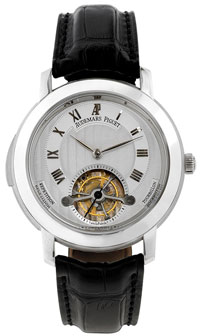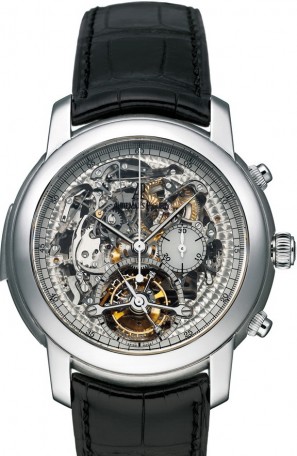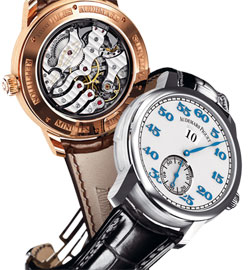|
According to historic facts, mechanic watches had appeared much earlier than bulbs lighted under ceiling and even earlier than gus-busners were invented. But, obviously, to know the time was the barest necessity, and as there were no any luminous colors invented, the watchmakers developed the repeater – a watch, which beats out time melodiously, providing with possibility to know the time, independently of lighting.
It should be noted that repeater and clock watch are not the same, although they can be combined in one case. The difference is that clock watches regularly announce the time even when there is no necessity at all, but repeaters “say” the time only when you “ask” it, i.e. push the button or lever, designed for it. It will inform about time as much as the power reserve enables and as you want.
Such mechanism allowed people to know the time in the past, without lighting a candle, as it was rather long and tiring process before matches were invented. Thus, this mechanism has some mystical peculiarity.
 The first quaternary repeater was patented by English watchmaker Daniel Quare in 1687 under King Jacob II. Those mechanisms beat the time by low tone strokes, and the number of past quarters – by high tone. So, pushing a button, say, at 22:56, you’ll hear 10 low tone and 3 high tone strokes. The first quaternary repeater was patented by English watchmaker Daniel Quare in 1687 under King Jacob II. Those mechanisms beat the time by low tone strokes, and the number of past quarters – by high tone. So, pushing a button, say, at 22:56, you’ll hear 10 low tone and 3 high tone strokes.
Usually, repeaters reproduce sounds of two tones: high and low. Each of them is made by two gong-hammers. Five-minute repeaters beat the time by high tones in 5 minutes intervals. So, at same 22:56 it will beat 10 low tone strokes with 3 double and 2 high tone strokes. Simpler repeaters, which don’t beat the quarters, are more often though: in this case you’ll hear 10 low tone and 10 high tone strokes. The minutes are beaten by high tone in minute repeaters. However that may be, once you learn to differ the strokes, you will easily interpret the sounds.
Success of first repeaters wasn’t long. In 1830, matches, gas and kerosene lamps appeared. Their light as if overshadowed the interest in repeaters, and the mechanism became a property of only true collectors and connoisseurs of this mechanism. The first repeater available as a wrist watch was the mechanism, produced by Audemars Piguet in 1892. Since then the company has become the leading supplier of such mechanisms at the world watch market.
“Audemars Piguet”: “Jules Audemars Tourbillon Repeater 10 minutes” – hand-wound movement (AP Caliber 2882) – tourbillon – 10-minute repeater
A combination of tourbillon and minute repeater is rather often in complicated models, manufactured in Le Brassus. The Jules Audemars Tourbillon Repeater 10 minutes model appeared in 2006, keeping all specific features of predecessor – a repeater of 2005 with two hammers and two gongs – in diminished 39 mm diameter case though.
Instead of traditional quarters the repeater beats hours, minutes and tens of minutes at request. A rather wide carriage of tourbillon created the necessity to move minute and hour indicators from the center, in which the designers succeeded. The model is released in two variants of case – of titanium and of pink gold (each version is made in 10 timepieces.
“Audemars Piguet”: “Jules Audemars Tourbillon Repeater Gronograph” – hand-wound movement (AP Caliber 2874) – tourbillon – minute repeater – chronograph with two counters Tourbillon Repeater Gronograph” – hand-wound movement (AP Caliber 2874) – tourbillon – minute repeater – chronograph with two counters
With a quite simple appearance of dial, this model – one of the most complicated in the brand catalogue – hides a virtuoso movement with tourbillon, minute repeater and chronograph inside its golden case of 43 mm diameter. The originality of this classic masterpiece of high watch art is emphasized by careful finishing of movement, hand-decorated in a style of Cotes de Geneve and Perlage and technique of Anglage. Central hands – “leaf”, small second hand at the carriage of tourbillon, and plaited Roman numerals, as in case, are made of pink gold. The version of platinum is also offered.
 “Audemars Piguet”: “Jules Audemars Jumping Hour Minute Repeater” – hand-wound movement (AP Caliber 2907) – minute repeater – “jumping” hour “Audemars Piguet”: “Jules Audemars Jumping Hour Minute Repeater” – hand-wound movement (AP Caliber 2907) – minute repeater – “jumping” hour
A combination of minute repeater with “jumping” hour – a quite rare complication – presents in new model from “Jules Audemars” collection. Its analogue was first proposed by manufactory from Le Brassus in 1924 as a pocket watch, made elegantly in the Art Deco style. The design of 2007 novelty practically repeats the appearance of rarity predecessor: the opening of “jumping” hour is at “12” hours, the small second hand is at “6” hours. The caliber AP 2907 design is obviously cast from the 1992 repeater movement, which is modified considering an enlarged case of 43 mm diameter now.
In 2010, Audemars Piguet presented its view for the popular complication, having manufactured the “Millenary Minute Repeater” model and therefore kept its traditions. This model is provided with new caliber 2910 with a system of two spirals and hand winding. Its power reserve makes up seven days. The oval case is made of matt titanium; the bezel is made of polished titanium. The model’s dial is “moved” to “3” hours, the position of “7” hours is taken by second additional dial.
|
